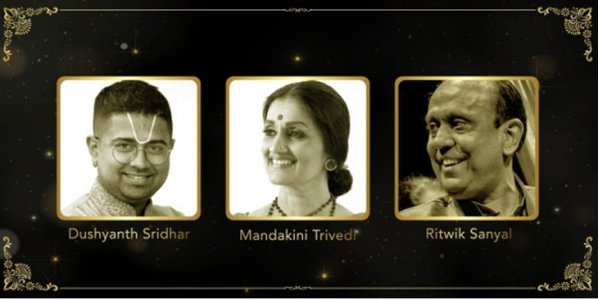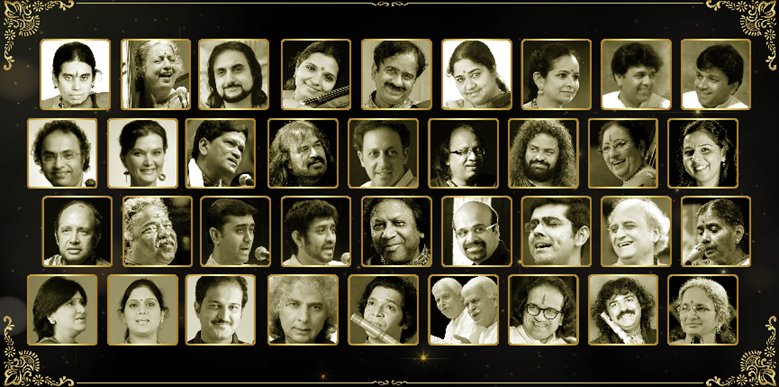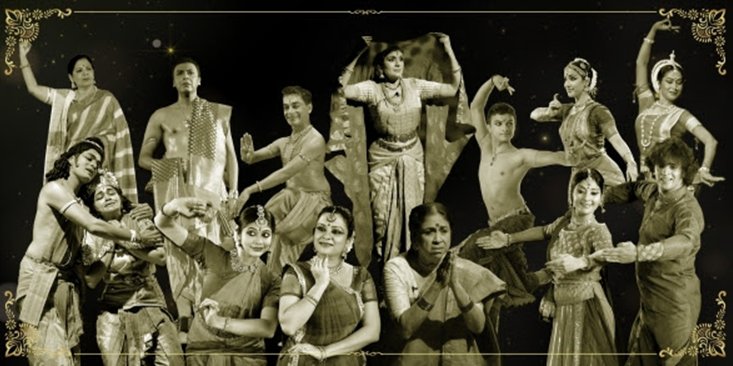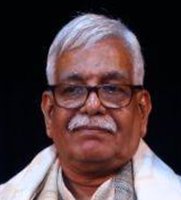
|   |

|   |
Naada Bindu festival: An overview - V.V.Ramani e-mail: ramanigaru@gmail.com March 12, 2021 One always experiences a great deal of happiness at the successful run of any endeavour. Standing at the first milestone, signifying a successful completion of 10 years, the Chinmaya Naada Bindu festival, an annual three day cultural festival held at Kolwan near Pune every year, also had to be re-imagined to be presented in a digital avatar due to the pandemic. Spread over 7 days, the festival was packed with meditation sessions, lectures by eminent speakers, music and dance encores, quiz and games. Envisaging the mammoth task of garnering attention to the arts in a very competitive digital world, the curators had to work hard, donning their thinking hats, to come up with a package that would cater and sustain the interest of a large, diverse rasika base. The committee therefore settled for an exciting package of excerpts, short segments edited from performances that were a part of the festival in the last decade. The music and dance encores, a package of performances spread over six sessions was an event, which viewers looked forward to with great enthusiasm, savouring it from the comforts of their home. But for serious practitioners of any art form looking for intellectual stimulation as well, the three sessions offering a multi dimensional insight into the arts - Kala Drishti was a wholesome, enlightening experience.  Dushyanth Sridhar, a popular name and a prolific speaker known for his lectures on varied topics related to Santana dharma, spoke about the Navarasas pertaining to Valmiki Ramayana. After an introduction to the meaning of rasa and how ashta rasas became navarasa, Dushyant highlighted specific incidents from the Ramayana narrative, which brought out the essence of each one of the rasas. He quoted verses in Sanskrit from the epic along with some detailed explanations. A little more theatrical delivery could have enhanced the emotions pertaining to that particular rasa more powerfully. Pt. Dr. Ritwik Sanyal, a singer, composer, academician and scholar gave a talk on Dhrupad- Musical substance, style and spirituality. He explained how Dhrupad was not just a musical genre but a complete musical system which was the springboard for all musical elements that followed like khayal, thumri etc. He also traced its historical reference in Natyashastra, about Mansingh Tomar who is acknowledged as the father of Dhrupad and his role in reconstructing the style sung in Madhya desi bhasha. The talk threw light on an aspect that many of us are not familiar with, which was the existence of a separate genre of performance - Dhrupad dance. The three salient features of Dhrupad -- Sur-melodic improvisation, Laya -rhythmic intensification and Pada-the lyrical component - and its aesthetics was dwelt in detail. This lecture was an enlightening session structured to address the scholars and seasoned learners. Another session that was fascinating was the session on Illustrated Yogic and Tantric practices in dance by the Mohiniyattam exponent, scholar Dr Mandakini Trivedi. This art form, she said, is multi-textured, multi-layered and can be divided into three sections - form, content, experience. Each of these sections can be divided once again into three parts namely - Aesthetic, Symbolic and Yogic. She conveyed the meanings of each part, explaining it beautifully with examples of significance by taking Anjali mudra and the golden mango story of Ganesha and Kartikeya. The explanations of the mandala and its equation with the dancing body in natyarambha position, the external form and the chakras within were explained with relevant slides. The speaker's clarity of thought, depth of knowledge and presentation, made it possible for even non-dancers to get an insight of the dancing body.  The music encore sessions curated by Pramodini Rao, was devised with a good blend of Carnatic and Hindustani styles of music as also a judicious mix, showcasing both vocal and instrumental performances. Interestingly, the first day's session veered towards highlighting duo performances. After a composition offered as salutation in praise of lord Ganesha, Ganesh and Kumaresh, the violin duo's rendition of Raghuvamsa sudha in raga Kadhanakudukalam gave a vibrant momentum to the festival, featured as the inaugural concert. The underlying core of virtuosity and vidwat of the artistes was evident as the musical passages and swaras steeped in melody, cascaded with great speed. Interestingly the curator's choice of playing the same song by A. Kanyakumari on another day, drew our attention to the individualistic approach each artiste follows and how that colours the rendering of the same song. The very popular songs in the Carnatic style, Jagadhodharana by Priya sisters, Chinnan chiru kiliye by Trichur Brothers or Main to leeno , the Meera bhajan by Begum Parveen Sultana in Hindustani style, that were a part of the scheduling continued to fascinate and the artistes' rendition of it was truly evocative and timeless. A galaxy of artistes regaled us with their performances, but the inclusion of a few conversations with artistes explaining the salient features of their instruments, sharing their experiences and anecdotes was an interesting addition. Rajan and Sajan Mishra's conversation excerpt spoke about their initiation to the art by their father. They narrated a memory of an experience that had a lasting impact on them. In their youth, he would call out to them for their musical riyaaz while they were engrossed playing games. He would tell them that the daily practice might feel like a chore, but the day you fall in love with sur and experience a deep connect, music would become more meaningful and it would become a sadhana. True enough it happened and from then on there was no looking back, they said. Nayan Ghosh's thoughts on musical appreciation and technicalities of tabla, Jayanthi Kumaresh's comparison of the veena and human body gave insights into their art forms and this helped the listeners enjoy their performances better.  Ramaa Bharadvaj, the curator of dance encore, had looked at her dance sequences with a distinct perspective garnering attention to varied aspects of the dance idiom. Parshwanath Upadhye's dramatic visualization dwelt on the narrative structure of the dance form, highlighting the story of Ganesha getting the elephant head while the emotional angle was dwelt in depth in the song Rusili Radha Rusala Madhav, danced by Mythili Prakash. It dealt in depth, how the state of anger between Radha and Krishna found resonance in every living being in Gokul. The myriad ways in which nature unravels its magic and wonder, its joyous interaction with every form of life, its many moods, were explored in a delightful manner by the dancing couple Nirupama and Rajendra. Ninda Stuti on a surface level focuses on humour, but at a deeper level has a deeper philosophical content. Shankar Kandaswamy managed to visualise the physical manifestation through his nritta and the spiritual depth through abhinaya in an engrossing manner. Finale of the day's show was a very patriotic, powerful depiction, capturing the spirit, essence and valour of Shivaji by Vaibhav Arekar and his group of dancers. Ramaa had managed to edit a full length performance of Shrimant Yogi into a smaller presentation without losing track of the momentum of the subject and performance. Ramayana never ceases to appeal to artists and rasikas alike, so it becomes a favourite subject for dance solos and group productions. Three different versions, a solo dance, a group production and a theatrical show chosen for the second day, were taken from different kandams of the epic. Beauty and grace combined with sensitive abhinaya were the highlights of Sujata Mohapatra's Odissi performance, whereas the Hanuman story visualised as a costume drama by Anita Guha's Bharathanjali was well rehearsed, full of vigour. Gowri Ramnarayan enacting the role of Mandodari as a solo act, fleshed out the persona and the emotions of the queen very poignantly. Jugalbandhis can be very monotonous at times, but Jazz Mine, a centennial dance tribute to Pt Ravi Shankar presented by Dakshina Vaidyanathan Bagel in Bharatanatyam style and Monisa Nayak in Kathak style to a musical score created by Pandit Ravi Shankar, flowed seamlessly from one to another. Rama Vaidyanathan's choreography was an imaginative and aesthetic blend of movements. Benedictions -A Sufi song with its meditative, philosophical ideas, expressed through rhythm and movement by Mythili Prakash came as a fitting finale to the season. Packed sessions through the day could have been a strain for the viewers, but by making it accessible to viewers for the whole month, rasikas got the opportunity to look at the performances at a leisurely pace and experience true rasanubhava. The festival, thanks to this online presence, managed to reach out to a larger audience base and created an interest in them to eagerly look forward to the next festival.  V.V.Ramani is a Chennai based multi-dimensional artist working in diverse fields ranging from collages and painting, teaching art, textile and costume designing, stage sets designing and wedding decor, to writing on visual and performing arts. |